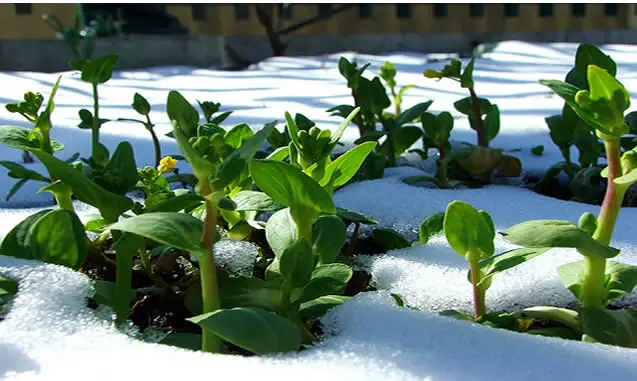The summer is ending and you have to say goodbye to those lovely blooming flowers and tasty vegetables. Or do you?
Gardening in the winter is not only possible but very rewarding. There are cold-hardy plants that grow quite well in the winter months to produce beautiful flowers and bountiful vegetable harvests. Here is a list of the best flowering plants and vegetables to plant in the winter and details of how best to get bountiful harvests and beautiful blooms.
Table of Contents
Winter Gardening Benefits
For those of us who love nothing more than getting down and dirty in garden soil, winter can be a bleak time. Putting away your trowel and hanging up your gardening gloves for several months until the warm weather returns can feel like a penance.
Winter usually spells the end of gardening for many. However, it doesn’t have to be.
 There are some great reasons for continuing to garden during the winter season and believe it or not sometimes the season can act in your favor.
There are some great reasons for continuing to garden during the winter season and believe it or not sometimes the season can act in your favor.
Winter brings with it lots of rain and a huge decline in the amount of pests, that normally attack plants in the warmer months.
Although there are blooming plants that you can cultivate during the winter months one of the best advantages of winter gardening is growing cold-hardy vegetables.
Nothing tastes as good a home grown vegetable especially if you grew it yourself.
There are also health benefits to winter gardening.
Winter tends to create a gloomy disposition as days are shorter and nights longer. Gardening during the daylight hours can keep you active during the winter when most people are huddled up with a warm beverage watching TV. Winter air is also good for you.
So what do you need to get started winter gardening?
Equipment Needed
Winter gardening brings with it challenges that do not exist in the summer. The most challenging thing of all is the cold.
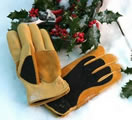 Protecting your hands from the cold is essential if you plan to garden in the winter and you can do this with something as simple as gardening gloves
Protecting your hands from the cold is essential if you plan to garden in the winter and you can do this with something as simple as gardening gloves.
You will need you tried-and-tested garden tools such as forks and trowels for tackling soil that tends to be more cold, hard and compacted in the winter.
Although using a greenhouse in the winter almost guarantees you can grow any type of crop, not everyone has access to one.
If you choose to grow plants in winter that are not very cold-hardy then you will need a greenhouse. At the very least you will have to fabricate some form of protection for them such using a covered frame that has some type of insulation and protection from rain and frost.
Luckily there are lots of cold-hardy plants that are more than happy to stay in the ground over winter.
Get Them in The Ground in Time
Regardless of the season it is always important to plant according to your zone so you give your crops the best chance of growing successfully.
However, 90% of successful winter gardening is making sure you have planted your flowers or vegetables before the cold weather stop them from maturing.
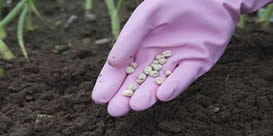 By giving plants enough time to mature they are much more likely to survive very cold spells and frost, though there are ways to protect them from frost.
By giving plants enough time to mature they are much more likely to survive very cold spells and frost, though there are ways to protect them from frost.
To ensure you have your plants in the ground in enough time for them to mature before the very cold weather hits, it is important to know the growth and maturity rates of the crops you are planting.
Don’t be dismayed if your first crops meet with disaster. Gardening is just as much an art as it is a skill and it will take you some time to master both.
After a few years of experimentation (with cold-hardy varieties of plants) you will know better than any seed packet, potted plant instructions or website what the best times are for planting your particular crops in your particular garden.
Planting for Your Area
The type of crops you plant will be largely dependent on the area in which you live.
Although there are cold-hardy blooming (flowering) plants and cold-hardy vegetables that live quite happily in colder temperatures the zone you live in will determine which ones are bested suited to your garden.
Zone Dependent Planting
Before you decide on what you want to plant it is a good idea to check the USDA Plant Hardiness Zone Map so you can determine which plant types will thrive best in your garden and also have a better understanding of optimal times for planting.
A USA mainland state will fall into one of nine zones, from zones 1 to 9.
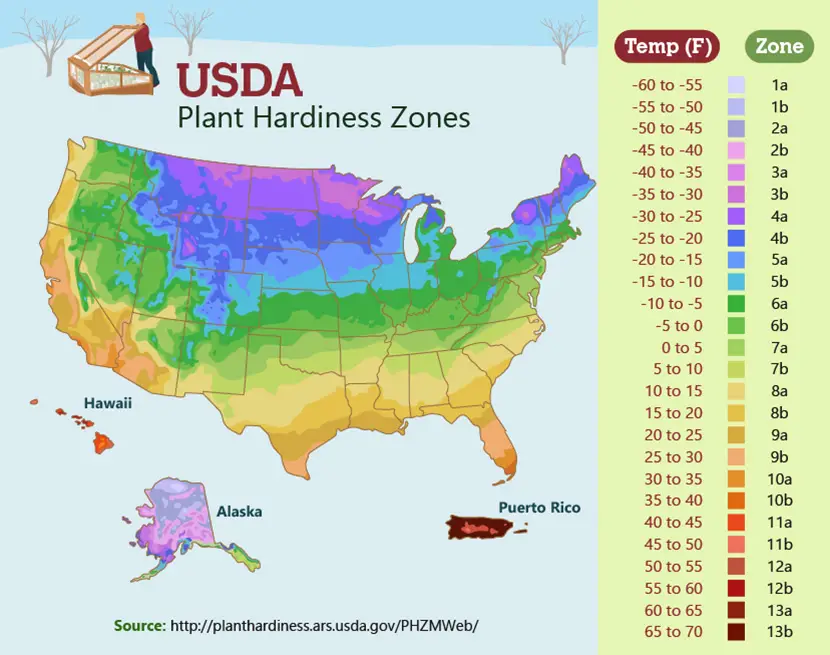
Zones 1, 2 & 3
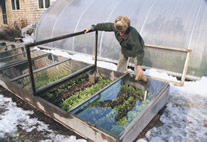 These are the coldest states that include Alaska and most northern continental states.
These are the coldest states that include Alaska and most northern continental states.
In these areas winter sunlight is at a minimal when temperatures can drop as low as -40 degrees Fahrenheit.
Obviously to grow anything in these conditions you need a greenhouse or other suitably enclosed area that is insulated and heated.
Zone 4
While not as cold as the previous zones, zone 4 does experience heavy snow fall and freezing temperatures during the winter months.
Some mountain areas in this zone can reach -30 degrees Fahrenheit.
 If you use a greenhouse or other enclosed system like a cold frame then you must snow-proof it to avoid collapse of the structure.
If you use a greenhouse or other enclosed system like a cold frame then you must snow-proof it to avoid collapse of the structure.
Make sure snow is not allowed to lie on anything that is put in place to protect your crops as it can bring down the temperature as well as put undue strain on the structure.
With low light you may want to use some form of artificial lighting in a greenhouse though most plants that are well insulated will survive on reduced light even if they don’t thrive.
Zones 5, 6, &7
Zones 5, 6 & 7 being in the middle of the country also get heavy snowfall in the winter months.
 However, the winter temperatures are not nearly as cold as the previous mentioned zones.
However, the winter temperatures are not nearly as cold as the previous mentioned zones.
The minimum temperatures range will be between -29 degrees Fahrenheit and -16 degrees Fahrenheit.
Zone 8
Winter temperatures usually stay above freezing in zone 8. However, there are some parts of this zone that do experience snow while other parts experience heavy rainfall.
 You will know which part your area falls into if you have lived there for any period of time.
You will know which part your area falls into if you have lived there for any period of time.
A tip to help with winter gardening in more arid areas is to use mulch for plant protection.
A horticultural garden fleece is usually all that is required when temperatures are set to dip low. Just be sure to remove it during the day light hours or your plants will be robbed of sunlight.
Zone 9
 Zone 9 offers the easiest winter gardening in the entire country.
Zone 9 offers the easiest winter gardening in the entire country.
In fact due to high summer temperatures and lack of rain growing crops in the winter can be easier.
Again on chilly nights use a horticultural fleece for protection remembering to remove it in the morning to allow the plants access to much-needed light.
Flowers To Grow in Winter
There are cold-hardy blooming (flowering) plants that can handle the chilly weather better than others.
When you cultivate these type of plants you can have flowers in the winter just like you do in the summer.
A point to note is that you should always remove dead flowers from your plants to prevent seeding. When you allow a plant to go to seed it spells the end of the life cycle and can also lead to unwanted new plants that clutter up your garden (which grow from the seed).
However, when you de-seed the plant by removing dead flowers you also stimulate new flower growth and give the plant a new lease of life.
Here are a few examples of flowers you can grow in the winter.
Bachelor’s Buttons
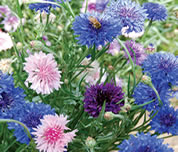 This cold-hardy flowing plant has a delightful hue that can add a splash of color to any winter garden.
This cold-hardy flowing plant has a delightful hue that can add a splash of color to any winter garden.
The plant is available with blue, pink and white flowers so different colors can be planted for a brighter look.
If you sow from seed then in the warmer zones plant in the fall while in the colder zones plant in spring.
Japanese Quince
 Japanese Quince is also known as “chaenomeles”.
Japanese Quince is also known as “chaenomeles”.
This is a hardy woody shrub that has thorny branches that bloom with cup shaped red flowers in the winter and early spring.
Cyclamen
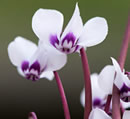 Cyclamen love the winter and bloom with beautiful colors in the colder months.
Cyclamen love the winter and bloom with beautiful colors in the colder months.
The flowers come in a range of colors including red, pink and white shades with purple offering you an amazing array of summer-like color throughout the winter.
List of Flowers The Bloom in Winter
Here is a quick list of some cold-hardy blooming plants that many people grow in the winter.
- Calendula
- Chionodoxa
- Clematis cirrhosa
- Crocus
- Cyclamen
- Daffodils
- Daphne
- Dogwood
- Heather
- Helleborus
- Honeywort
- Iris unguicularis
- Japanese quince
- Mahonia
- Pansies
- Pinks
- Sarcococca
- Skimmia japonica
- Snowdrops
- Sweet Alyssum
- Sweet Pea
- Viburnum
- Violets
- Winter aconites
- Winter Honeysuckle
- Winter jasmine
- Winter-flowering cherry
- Witch hazel
Of course this list is not complete as there are many more blooming plants that can liven up your garden in the winter months.
I advise you to do a little a research into winter crops that are native to your area as you may find a few gems for your garden. As those plants will be native to your part of the country it is almost assured that they will take root.
Vegetables to Grow in Winter
Of course flowering plants aren’t the only thing you can grow during the winter. There are many cold-hardy vegetables that you can grow.
You could be gracing your plate with your very own homegrown veg throughout the winter season.
Here are a few examples of vegetables you can grow in the winter.
Kohlrabi
 Kohlrabi is a vegetable that is similar to turnip.
Kohlrabi is a vegetable that is similar to turnip.
However it is much milder and has a sweeter taste than turnip.
Kohlrabi is not only great in salads but many people stir fry and pickle it.
You can grow this tasty vegetable in winter as long you as protect it against freezing.
It grows especially well in a winter greenhouse.
Leeks
 Leeks are a great vegetable to grow in the winter season.
Leeks are a great vegetable to grow in the winter season.
However, you do need to sow them in containers and allow them to germinate into healthy seedlings before transplanting them into the ground.
After that this versatile vegetable will grow strong and healthy despite the cold.
Broccoli
 Broccoli is packed with vitamins, amino acids, fiber, and minerals and has more protein per calorie than beef!
Broccoli is packed with vitamins, amino acids, fiber, and minerals and has more protein per calorie than beef!
Cool temperatures can actually help the flowers firm, so broccoli is a vegetable that thrives in the winter months.
Here is a quick list of some cold-hardy blooming plants that many people grow in the winter.
List of Vegetables You Can Grow in Winter
Here is a quick list of some cold-hardy vegetables that many people grow in the winter.
- Asparagus
- Broad beans
- Broccoli
- Cabbage
- Carrots
- Garlic
- Kohlrabi
- Leeks
- Onions and Shallots
- Peas
- Spinach
- Spring Onions (Scallions if you’re Irish)

